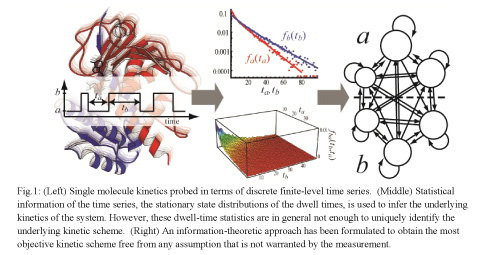Understanding how a molecule functions by taking its pulse
Research Press Release | August 08, 2013

| Press Release | ||
|---|---|---|
| Key Points |
– First successful development of a novel algorithm capable of objective determination and prediction of molecular state from time-series data in terms of network. – Elucidation of dynamic changes in the network of enzymatic states dependent on the concentration of the substrate. – Major potential for innovative, effective experimental guidelines based on data science. |
|
| Overview |
A research group in the Research Institute for Electronic Science, Hokkaido University (director Hiroaki Misawa) headed by Associate Professor Chun-Biu Li of the Molecular & Life Nonlinear Sciences Laboratory and Professor Tamiki Komatsuzaki has succeeded in developing a new analytical procedure that anticipates possible future data output from molecules by using networks as an expression for the objective evaluation of molecular states, based on time-series data for molecules with finite, discontinuous, discrete values. What can we learn about the working mechanisms of a bio-molecule if only the time series of a certain system property, e.g., a sequence of durations the molecule is in the compact/extended form, is available from measurement? This poses a problem conceptually similar to that of the pulse diagnosis of a patient’s physiological conditions in oriental medicine. A common challenge to both situations is how one can infer useful information from limited data while at the same time avoiding possible prejudices imposed by the analyst that cannot be justified by the measurement. In this work, we carefully examine the statistical information contained in a time series such that the amount of information associated with the analyst’s prejudice is quantified and minimized. As a result, the most objective diagnosis, in the form of a reaction network, can be constructed to model the working mechanisms of the observed molecule. The resulting network that contains nodes (molecular states) and connections (transitions between states) allows us to faithfully summarize, explain, and predict the molecular behaviors solely based on the time series (pulse) of the observed molecule (patient). |
|
| Inquiries | Tamiki Komatsuzaki, Professor, Research Institute for Electronic Science, Hokkaido University
TEL: 011-706-9434 FAX: 011-706-9434 e-mail: tamiki@es.hokudai.ac.jp |
|
| Japanese Link | http://www.hokudai.ac.jp/news/130803_pr_es.pdf | |
